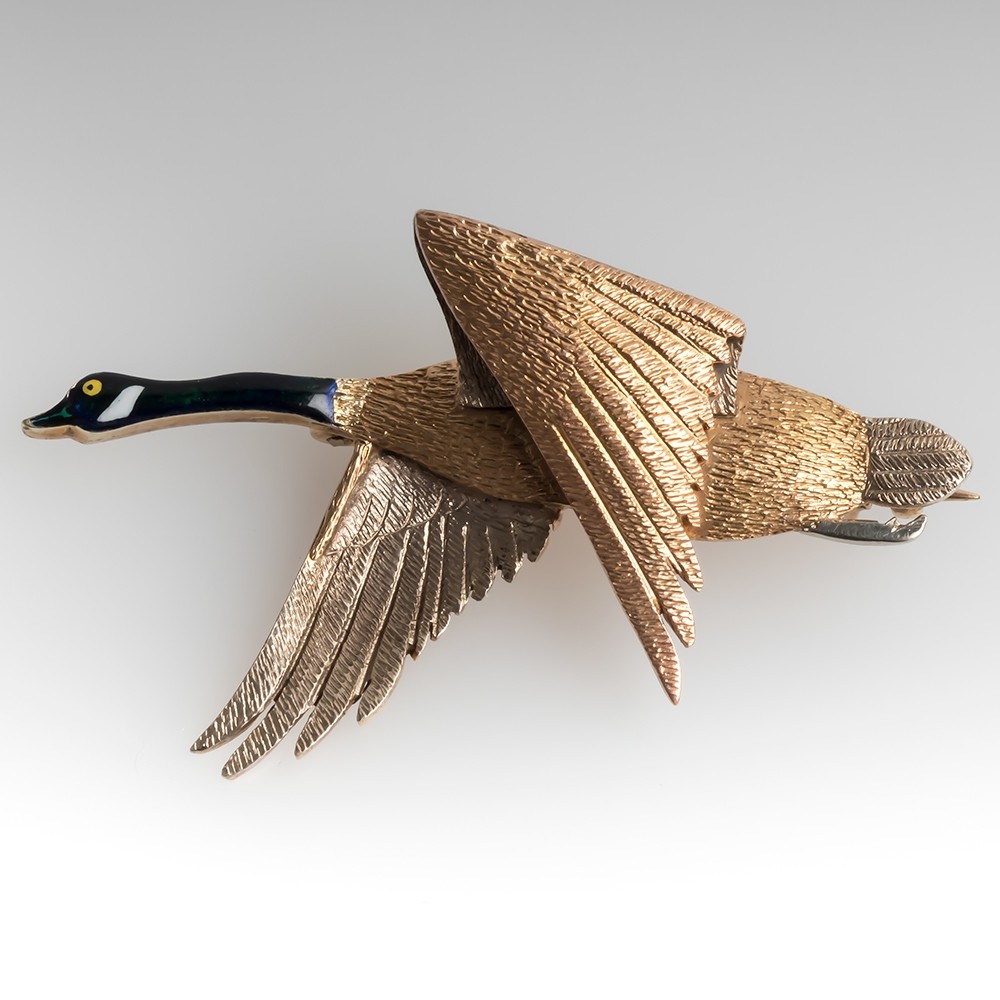Posted in: Designer Spotlights
 Birds, like this Canadian Goose brooch, were a favorite Verdura motif. Of course, his birds were literally iced with jewels to add to their magnificence. Photo copyright EraGem.
A golden swan fashioned by Verdura flies through the air carrying a large faceted diamond in its beak (see image here). Diamonds pave its collar, and its large body, made from a single Baroque pearl, appears to have been etched with tail feathers. Draped across its broad chest lies a diamond necklace, and it wears two diamond bands around its onyx ankles.
Birds, like this Canadian Goose brooch, were a favorite Verdura motif. Of course, his birds were literally iced with jewels to add to their magnificence. Photo copyright EraGem.
A golden swan fashioned by Verdura flies through the air carrying a large faceted diamond in its beak (see image here). Diamonds pave its collar, and its large body, made from a single Baroque pearl, appears to have been etched with tail feathers. Draped across its broad chest lies a diamond necklace, and it wears two diamond bands around its onyx ankles.
Verdura + His Three Swans
One of three jeweled swan pins made by Duke Fulco di Verdura, this stunning vintage brooch was fashioned in 1948 for society maven Barbara 'Babe' Paley. Though the legendary jeweler made several variations on this theme of swans, he made this one first. Two other followed, which he gave to Ms. Paley's contemporaries, Fiat's first lady, Dona Marella Agnelli, and the "statuesque Mexican beauty" {cited}, Mrs. Gloria Guinness.Renaissance Symbolism
A representative at Verdura confirmed that the masterful jeweler would have drawn heavily from Renaissance symbolism for his design of the swan brooches. Although any conclusions made by this writer are estimations at best (speculations at worst), a brief study of Renaissance imagery and literature allows for the possibility that Signor Verdura endowed these swans, and therefore the three powerful women he gifted them to, with eloquent meaning drawn from Greek mythology. Lauded by Elsa Maxwell, famous international hostess and gossip columnist, as someone who would "guarantee the 'most perfect party imaginable'" {cited}, Duke Fulco di Verdura was well versed in Renaissance and Romantic literature, art, and culture. He kept numerous volumes on the art and literature of those historic periods in his library, which served as reference for both work and pleasure. Drawing from this rich cultural epoch, Signor Verdura enjoyed playing with references and weaving double meanings and rich symbolism into his jewelry and his conversation. His use of the Baroque pearl in this brooch serves as further evidence for his inspiration from Renaissance Italy. Signor Verdura crafted many whimsical animals out of these asymmetrical cultured pearls, likely inspired by the Baroque jewelry viewed in the European museums he visited in his younger years.Queens of Song
In her 1996 text, The Woman's Encyclopedia of Myths and Secrets, Barbara Walker proposes that swans symbolize the Greek Muses, attendants to Apollo, god of music and poetry. A simple conclusion that the swan brooches were symbolic of the designer's affections for these women who served as muses might be made. However, another far richer symbolism may surround these unique creations. For wherever the Muses went, so went the Three Graces (Thalia, Euphrosyne, and Aglaia) , those patronesses of the arts who reigned as "queens of song and orderers of the festivals in heaven and on earth" {The Spenser Encyclopedia}. In some texts, it is inferred that swans represents not only the Muses, but also the Three Graces. Writing in England in the 1500s, poet Edmund Spenser, whose work Signor Verduri would have been familiar with, referred frequently to the service of Three Graces to those "earthly ladies of great beauty or position" {The Spenser Encyclopedia}. Another story involving the three sisters is the epic Greek narrative Of the Judgement of Paris, which became very popular among the social elite in the early 1950s. In fact, it's quite possible that these works of antiquity became popular because the Duke regaled his social equals of the mythological tales at their splendid parties. Most certainly, he would have shared these details during one of his collaborative design sessions with his clients, including Babe Paley.Orderers of Feasts and Parties
In one version of the legendary story, the Three Graces promise to confer their inherent virtues onto England's Queen Anne. Sister Thalia offers the Queen "contynuall success" or "ryches", Euphrosyne bestows "hartie gladnes" or "felicitie", and Aglaia grants "stable honour" or "wysdome" {Empire and Nation in Early English Renaissance Literature}. It is no great leap to consider that hidden within these swan brooches was Signor Verdura's hope that the Three Graces would bestow these same gifts upon three of his favorite society women, women who in their day were the reigning "orderers" of splendid feasts and parties on earth. ~Angela Magnotti Andrews11 years ago
3 view(s) 